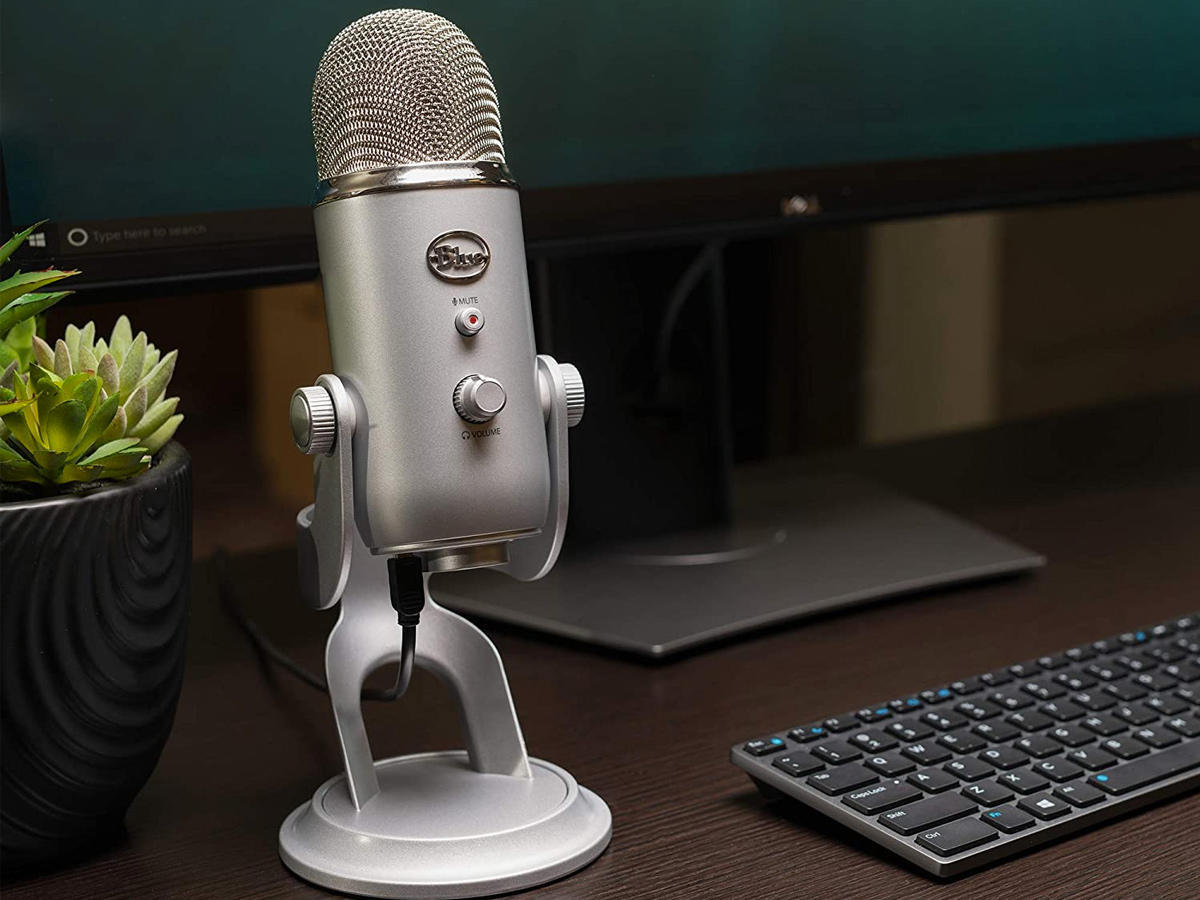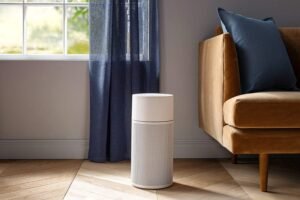
This is the review of the comparison between two microphones from the same brand and also from the same series. The comparison here is between the Blue Yeti Nano and the Blue Yeti. There is around thirty dollars difference in their price range which brings the difference in their features and performances too. To know which one is good to buy for you, go to the detailed review.
 |  |
| Blue Yeti Nano | Blue Yeti |
| BUY NOW | BUY NOW |
| PROS | PROS |
| Two capsules provide cardioid or omnidirectional polar patterns. Excellent broadcast sound quality. Illuminated control dial. Plug and play – no installation. Headphone jack with low-latency monitoring. | Multiple recording patterns. THX-certified sound quality. Record directly to your PC without an audio interface. Fantastic for the price. |
| CONS | CONS |
| Gain is only adjustable via Sherpa software. Only two polar patterns. No multi-head setup. No pop filter or windscreen. | No multi-head setup. The wobbly plastic knobs make us wary about durability. No XLR output on the standard version. |
SPECIFICATIONS:
| HEADER | BLUE YETI NANO | BLUE YETI |
| Brand | Blue Microphones | Blue Microphones |
| Product Line | Blue Microphones Yeti | Blue Microphones Yeti |
| Model | Nano | |
| GENERAL | BLUE YETI NANO | BLUE YETI |
| Manufacturer | Logitech | Logitech |
| Recommended Use | computer | Professional audio – instrument, vocal, voice, recording |
| MICROPHONE | BLUE YETI NANO | BLUE YETI |
| Microphone Technology | electret condenser | electret condenser |
| Microphone Operation Mode | cardioid / omni-directional / bi-directional (switchable), stereo | |
| Sensitivity | -37 dB | |
| Microphone Power Source Voultage (DC) | ||
| Frequency Response | 20 Hz | 20 Hz |
| Signal-To-Noise Ratio | 120 db | |
| Total Harmonic Distortion (THD) | 0.5% | |
| Max Sound Pressure | 110 db | 120 db |
| Audio Input Details | Cardioid / omni-directional / bi-directional (switchable) – 20 – 20000 Hz | |
| Connectivity Technology | Wired | Wired |
| AUDIO SYSTEM | BLUE YETI NANO | BLUE YETI |
| Type | Microphone | Microphone |
| Recommended Use | computer | Professional audio |
| Specific Applications | broadcast, recording | Instrument, recording, vocal, and voice |
| Additional Functions | Amplifier | |
| Controls | Mute, volume | |
| DIMENSIONS & WEIGHT | BLUE YETI NANO | BLUE YETI |
| Component | microphone, microphone stand | |
| Width | 3.8 in | 4.7 in |
| Depth | 4.3 in | 4.9 in |
| Height | 8.3 in | 11.6 in |
| Weight | 22.22 oz | 19.4 oz, 2.2 lbs |
| FEATURES | BLUE YETI NANO | BLUE YETI |
| Features | Perfect for vocals, musical instruments, podcasting / Podcasts, voiceovers, interviews, field recordings, conference calls, streaming, gaming, and gaming commentary. No-latency headphone output, headphone volume and mic mute. Standard threading for radius III shock mount and/or compass boom arm. Plug’N play Mac and PC compatible.. Cardioid and Omni pickup patterns; supports sample rates up to 24-bit / 48 KHz. | Tri-capsule Array – 3 Condenser Capsules Can Record Almost Any Situation. Multiple Pattern Selection – Cardioid, Bidirectional, Omnidirectional & Stereo. Gain Control, Mute Button, Zero-latency Headphone Output. Perfect for vocals, musical instruments, podcasting / Podcasts, voiceovers, interviews, field recordings, conference calls, streaming, gaming, and gaming commentary. Plug and play – Mac OS X (10.4.11 or Higher) and PC (Windows 8.1, 8, 7, Vista, XP). |
Detail Review:
INTRODUCTION:
Blue Yeti Nano
The Blue Yeti Nano is like a younger brother of the Blue Yeti or the Blue Yeti Pro. This is also a budget-friendly microphone available in the market. This microphone is retailing for around a hundred dollars currently which is along the lower budget side. This microphone has two polar patterns such as the cardioid and the omnidirectional.
Blue Yeti
The Blue Yeti is one of the popular microphones in the market from the Yeti series microphone. This microphone is retailing for around a hundred and thirty dollars which is neither more nor on the lower side price range. The price on this microphone is only thirty dollars more than the Blue Yeti Nano.

DESIGN:
Blue Yeti Nano
As far as the build quality of this microphone, there’s nothing spectacular about it but you really shouldn’t be expecting that for $100. The body does feel pretty plasticky and cheap, it does have a metal mesh grille and it is a bit on the light side. On the front of the microphone, you will find a single dial which is the headphone volume control, and you can also press this button to mute the microphone.
On the back of the microphone, you’ll find the polar pattern selection switch to switch between cardioid or omnidirectional, and you can also hold this button for two seconds to turn on or off the zero-latency monitoring. Then lastly, on the bottom of the microphone, you will find the USB port to connect it to your computer, you’ll find the 3.5-millimeter headphone port, which does offer zero-latency monitoring as well as computer playback, and in the middle, you will find quarter-inch threading to mount it to a tripod, or you can use the provided adapter to mount this to a standard microphone stand.
Blue Yeti
As far as the build quality on this mic, it’s really sturdy and this mic has got a great weight to the stand so that it stays in place properly. On the front side of the mic, you have got the Blue logo and below the logo is where you have got the mute button. The mute has also got a LED that starts flashing on muted and glows red on unmuted. Also, on the front side of the mic is where you have got your volume dial for your headphones.
You have also got the gain knob in this mic while most of the mic doesn’t have the gain knob within the mic. On the backside, if the mic is where you have got the gain knob and also, you have got a switch to select one among four polar patterns within the backside of the mic. Underneath the mic, you have two ports for this mic. As this is a USB mic, you have got a USB port to connect to your computer and the other port is your headphone jack.

FEATURES:
Blue Yeti Nano
In the box, you do obviously get the microphone which has a desktop stand already installed, you get a 1/4 inch to 5/8 inch microphone stand adapter, you get a USB cable, you get some documentation as well as a trial for Xsplit. As far as the specs, this thing has a cardioid or omnidirectional polar pattern, it has a frequency response of 20 Hertz to 20 kilohertz, a sensitivity of around -37 decibels, a bit depth of 16 or 24 bit, and a sampling rate of 32 to 48 kilohertz.
When I checked out the latency for the Blue Yeti Nano when it’s being recorded at 48 kilohertz, with an i/o buffer size of 64 samples we have 9 and 1/2 milliseconds round-trip, or three and 1/2 milliseconds output, bump up to 128 we’re at 12 and 1/2 milliseconds round-trip or 5 milliseconds output, and if we jump up to 256 18 milliseconds round-trip and 8 milliseconds output.
You need to download the Blue Sherpa software to get your gain settings. In the Blue Sherpa software, the first thing you will find is the format of the recording and that allows you to change between 24-bit 48 kilohertz all the way down to 32 kilohertz. Then next you’ll find the microphone gain which is pretty self-explanatory, this allows you to adjust the gain of the microphone within the software, very straightforward. Then you have the polar pattern selection switch which allows you to switch between cardioid or we can switch to omnidirectional.
Then finally you’ll find the playback settings in the software, which control what you’re hearing in the headphones coming out of the Blue Yeti Nano. So, what the playback level slider does is adjust the amount of your computer’s playback that you’re hearing in your headphones, and you can also just go ahead and hit the mute button to completely mute your computer’s playback. Then if you do want to turn off the direct monitoring, or zero-latency monitoring, all you have to do is hold the polar pattern selection switch on the rear of the microphone for 2 seconds, and it will turn it off or on, and that’s actually it for the Blue Sherpa software is pretty straightforward and very easy to use.
Blue Yeti
The Blue Yeti has got a solid build quality to it and it is covered with metal all over. This microphone is not only coming in black color but also in silver color. It comes in a nicely packed box and inside the box, you are going to get your microphone themselves, a USB cable as this is a USB microphone, some papers, manuals, and warranty information, and the stand for this mic.
One of the great features of this microphone is that you don’t need to download separate software for this microphone to get the advantage of gain control because you have got the gain knob within the microphone itself. The gain knob is to control the preamps and to control the sound this microphone has to record. Also, without the software, you can control the volume on your headphones using the volume knob in the microphone.
This microphone is also an all-rounder microphone as this microphone comes with three condenser capsules which give us four polar patterns all in one mic. You have got the cardioid pattern, stereo pattern, omnidirectional pattern, and last is a bi-directional pattern.

PERFORMANCE:
Blue Yeti Nano
The preamp on this microphone is pretty noisy, it is also somewhat sibling, it picks up quite a bit of ambient noise. As far as my overall thoughts on, the electric guitar the slightly recessed midsection gives it an almost scooped sound, so I’m not the biggest fan of it there. But if you’re just using this microphone for demos or doing YouTube covers, I think it would be perfectly fine. Then the outcome for the acoustic guitar is the exact same story, I think the recessed midsection is really a detriment to that instrument. It kind of removes a little bit of the body and just over focuses on the lows and the highs.
For singing, that’s where the midsection really becomes apparent because when I was playing the acoustic guitar and singing, the vocals almost got lost in that mix. So, if you’re trying to make your vocals pop or sit on top of a mix when you are recording I don’t think this is gonna work for you at all. But then for spoken word, I actually think this microphone offers a very clean and crisp sound, and that cut to the mids that I’ve been complaining about so much actually removes a bit of nasal tone which will appeal to a lot of people. So, for the spoken word I do actually think it will work for some people.
Blue Yeti
The performance of this microphone is really nice. It has got four polar patterns and each one performs its function in a nice and different way. With the cardioid pattern, this mic will record the sound from both the left and right sides, and from the front leaving the backside of the mic. In actual it records the sound in a heart patterned way. The stereo pattern is where it will record the sound from the left and the right sides only. In the omnidirectional pattern, it will record the sound from all 360 degrees, and in the bi-directional pattern, it will record from the front and back sides only.
This microphone really performs all the polar patterns very well. The vocals were clear for both solo spoken words and while singing also. This definitely a great microphone for voiceover, streamers, podcasters, and singers also. It really does its job very well. At this price range, this really a great microphone having such a great sound quality with all four polar patterns.

WHICH ONE IS FOR YOU?
If you were planning on picking up the Blue Yeti only for solo spoken word, don’t go ahead and just go with the Blue Yeti Nano because there’s no reason to pay the extra money for a bunch of capsules and polar patterns that you probably shouldn’t be using. But then on the other hand, if you were deliberating between these two microphones for either music and also for streaming and podcasting, I would still direct you to the original Blue Yeti because this is still one of the cheapest ways to get a decent sounding stereo microphone set and for music and also a cardioid microphone for podcasting and streaming, I would also prefer the more present mids of the original Yeti.
Expert Reviews of Blue Yeti Nano:
By PCMag
The reasonably priced Blue Yeti Nano USB microphone delivers high-quality, crisp audio with two selectable polar patterns and a DSP-free signal chain.By Laptop Mag
The Blue Yeti Nano combines excellent sound quality and easy setup with a lightweight, premium design.By Tom’s Hardware
At the expense of a couple of extra polar patterns, the Blue Yeti Nano is a fantastic way to get that clean, refined Yeti sound for less than other mics in the lineup.By Tech Radar
The Blue Yeti is a great option for anyone who just wants to plug in and play without spending hours tweaking audio settings.By IGN
Blue continues its dominance of the USB podcasting mic space with the Yeti Nano. The smaller size is generally a bonus, and while there are a few features missing due to its shrinkage, the sound quality…Expert Reviews of Blue Yeti:
By Podcastinsights
Even though the Blue Yeti tends to be popular with beginners (it was the first external microphone I bought), I find that it performs much better in the hands of someone slightly more experienced with audio recording.By TechRadar
The Blue Yeti is a great option for anyone who just wants to plug in and play without spending hours tweaking audio settings.By cnet
The Yeti is one of the richest sounding, sonically flexible USB microphones money can buy, but its large size makes it inconvenient for portable applications.By MusicRadar
For podcasting, streaming, and video conferencing, the Blue Yeti is still as simple and easy to use as ever. Highly recommended.By the podcast host
I think it’s a great option for someone looking for a simple set-up, but also a decent level of sound quality. The Yeti certainly sounds better than its little brother, the Blue Snowball, which is another popular starter microphone.




